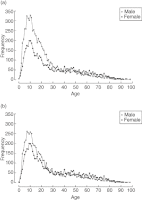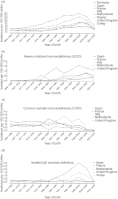The European internet-based patient and research database for primary immunodeficiencies: update 2011
- PMID: 22288591
- PMCID: PMC3374280
- DOI: 10.1111/j.1365-2249.2011.04542.x
The European internet-based patient and research database for primary immunodeficiencies: update 2011
Retraction in
-
Retraction. The European internet-based patient and research database for primary immunodeficiencies.Clin Exp Immunol. 2012 Jul;169(1):70. doi: 10.1111/j.1365-2249.2012.04593.x. Clin Exp Immunol. 2012. PMID: 22670780 Free PMC article. No abstract available.
Abstract
In order to build a common data pool and estimate the disease burden of primary immunodeficiencies (PID) in Europe, the European Society for Immunodeficiencies (ESID) has developed an internet-based database for clinical and research data on patients with PID. This database is a platform for epidemiological analyses as well as the development of new diagnostic and therapeutic strategies and the identification of novel disease-associated genes. Since its start in 2004, 13,708 patients from 41 countries have been documented in the ESID database. Common variable immunodeficiency (CVID) represents the most common entity with 2880 patients or 21% of all entries, followed by selective immunoglobulin A (sIgA) deficiency (1424 patients, 10·4%). The total documented prevalence of PID is highest in France, with five patients per 100,000 inhabitants. The highest documented prevalence for a single disease is 1·3 per 100,000 inhabitants for sIgA deficiency in Hungary. The highest reported incidence of PID per 100,000 live births was 16·2 for the period 1999-2002 in France. The highest reported incidence rate for a single disease was 6·7 for sIgA deficiency in Spain for the period 1999-2002. The genetic cause was known in 36·2% of all registered patients. Consanguinity was reported in 8·8%, and 18·5% of patients were reported to be familial cases; 27·9% of patients were diagnosed after the age of 16. We did not observe a significant decrease in the diagnostic delay for most diseases between 1987 and 2010. The most frequently reported long-term medication is immunoglobulin replacement.
© 2011 The Authors. Clinical and Experimental Immunology © 2011 British Society for Immunology.
Figures



References
-
- Geha RS, Notarangelo LD, Casanova JL, et al. for the International Union of Immunological Societies Primary Immunodeficiency Diseases Classification Committee Primary immunodeficiency diseases: an update from the International Union of Immunological Societies Primary Immunodeficiency Diseases Classification Committee. J Allergy Clin Immunol. 2007;120:776–94. - PMC - PubMed
-
- Boyle JM, Buckley RH. Population prevalence of diagnosed primary immunodeficiency diseases in the United States. J Clin Immunol. 2007;27:497–502. Epub 19 June 2007. - PubMed
-
- Centre de Référence Déficits Immunitaires Héréditaires (CEREDIH): the French PID Study Group. The French national registry of primary immunodeficiency diseases. Clin Immunol. 2010;135:264–72. - PubMed
-
- Kirkpatrick P, Riminton S. Primary immunodeficiency diseases in Australia and New Zealand. J Clin Immunol. 2007;27:517–24. - PubMed
Publication types
MeSH terms
Substances
LinkOut - more resources
Full Text Sources

